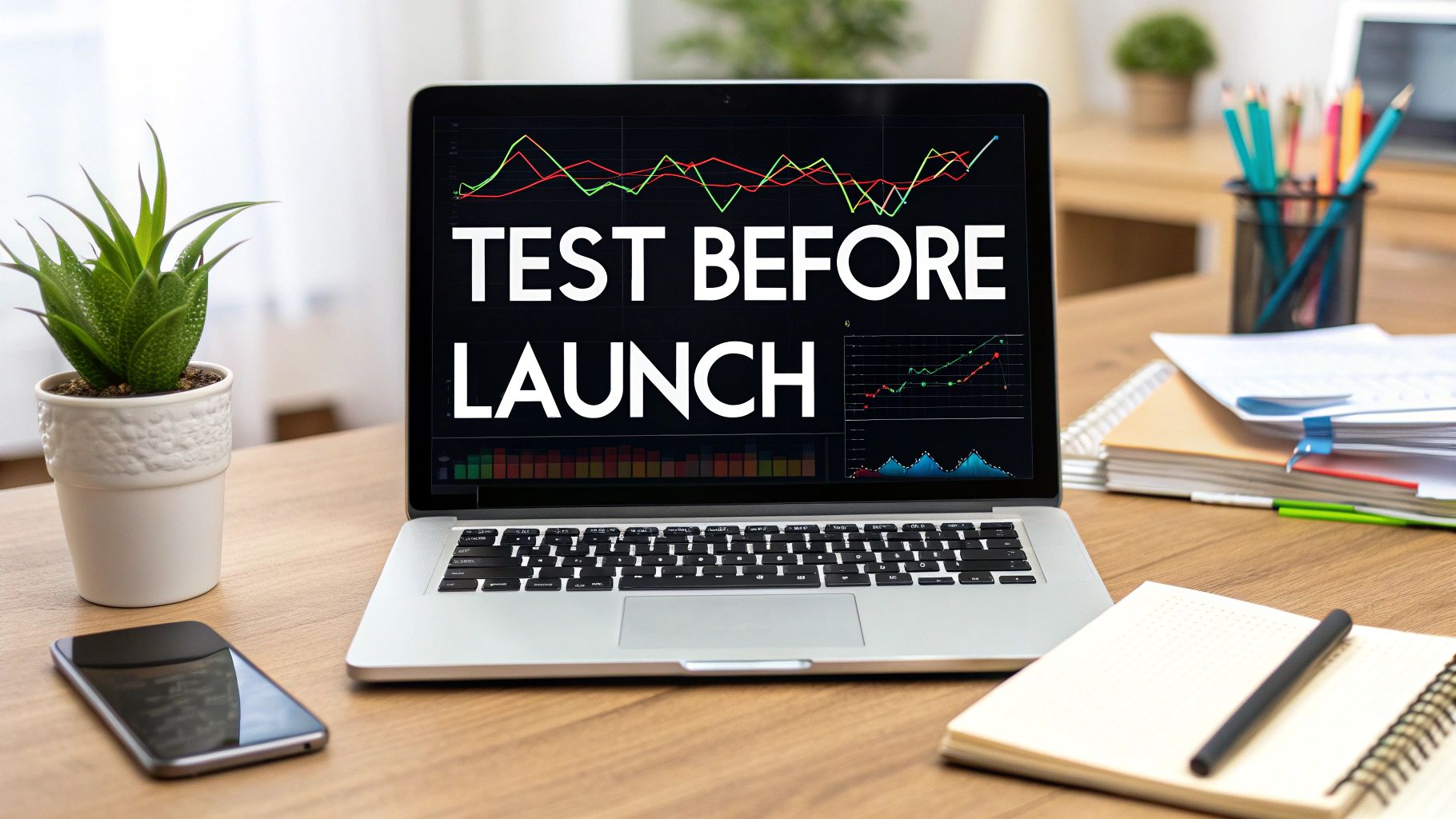Why Smart Entrepreneurs Test Business Ideas First
Launching a business can be exciting, but it also requires careful planning. Many entrepreneurs invest significant time, energy, and resources into building something they believe in, only to find there's no market demand. That's why testing your business idea before launching is essential. It allows you to validate your assumptions and minimize the risk of costly mistakes, replacing hope with data-driven decisions.
The High Cost of Unvalidated Assumptions
Driven by enthusiasm and a desire to launch quickly, many entrepreneurs skip the crucial step of validating their business ideas. They underestimate the importance of market research and overestimate the readiness of their product or service. This can lead to significant financial losses and wasted effort. Imagine developing a complex SaaS platform only to discover your target audience prefers a simpler, more affordable option. Sadly, this is a common occurrence. Startup failure rates are high, with 90% failing overall, 10% within the first year, and 70% by the fifth year. Find more detailed statistics here A significant portion of these failures stems from a lack of product-market fit and an ineffective marketing strategy.
The Benefits of Early Validation
Testing your business idea early offers numerous advantages:
- Confirm Market Demand: Ensure there's a real need and audience for your product or service.
- Refine Your Offering: Gather feedback and identify areas for improvement to tailor your product to customer preferences.
- Reduce Financial Risk: Avoid wasting resources on developing something that won't sell.
- Attract Investors: Demonstrate market validation and increase your chances of securing funding.
- Build Confidence: Launch with the assurance that you're on the right path, backed by real-world data.
Overcoming the Psychology of Skipping Validation
The temptation to skip testing often arises from psychological biases. Entrepreneurs can become emotionally attached to their ideas, developing a "blind spot" to potential flaws. Fear of negative feedback can also be a deterrent. However, a growth mindset is crucial. View feedback as an opportunity for improvement. Testing should be seen as a conversation with your potential customers, allowing you to learn, adapt, and build a stronger, more successful business.
Industry Patterns That Shape Your Testing Strategy

Different industries present unique testing challenges and opportunities for business ideas. For example, validation in a heavily regulated industry like healthcare looks quite different from that in the food service industry. Understanding your industry's specific dynamics is crucial for effective testing. Market maturity also plays a significant role. Testing a new social media app in a saturated market requires a different strategy compared to introducing a novel medical device in a less crowded space.
Industry-specific failure rates also influence testing approaches. The technology industry, for instance, sees 63% of startups failing within five years. Conversely, the healthcare industry has demonstrated strength, with US healthcare startups generating substantial revenue in recent years. Understanding these statistics can help entrepreneurs tailor their testing to each sector’s challenges. More detailed statistics can be found in this Startup Statistics Guide. Researching industry-specific data is an important first step before testing any business idea.
Competitive Landscapes and Regulatory Environments
The competitive landscape significantly impacts your testing strategy. A highly competitive market demands rigorous testing to ensure your idea stands out. Regulatory environments also play a key role. Industries with strict regulations, such as pharmaceuticals or finance, require more extensive testing to comply with legal requirements.
This is especially true for international businesses. Varying regulations across different regions necessitate adaptable testing methods. Entrepreneurs need to understand the requirements of different visa categories. One potential niche to test is insurance for specific visa holders, such as Golden Visa Insurance.
Adapting Your Testing Approach
Successful entrepreneurs adapt their testing methods to their specific industry. In fast-paced industries like technology, rapid prototyping and iterative testing are essential. In contrast, industries with longer sales cycles, like enterprise software, might benefit more from in-depth customer research and pilot programs.
This highlights the need for a flexible and tailored testing approach. By carefully considering industry patterns, regulations, and competitive forces, you can refine your testing strategy and improve your chances of success.
Location-Based Factors That Impact Your Validation
Your business idea might be brilliant, but its success isn't solely dependent on its inherent qualities. Where you choose to test and launch your business plays a crucial role. Just as natural ecosystems vary, so too do business environments. These variations significantly impact testing strategies and your chances of success.
Regional Startup Success and Failure Rates
Geography influences a startup's trajectory, affecting both testing and overall success rates. The startup landscape differs significantly from country to country. In the United States, startups face an 80% failure rate, with the technology sector particularly challenging. Canada's rate is even higher at 90%, while the UK experiences a 60% failure rate.
Understanding these regional challenges helps entrepreneurs anticipate hurdles and formulate strategies. More detailed statistics can be found here. This data underscores the importance of location-specific validation.
The Influence of Local Ecosystems
Thriving startup hubs often have specific attributes that contribute to their success. Silicon Valley, for instance, benefits from concentrated venture capital, a skilled workforce, and a risk-taking culture. Other regions might have different strengths, such as strong manufacturing industries, access to raw materials, or supportive government policies. Recognizing these location-based advantages and disadvantages is crucial for tailoring validation methods.
Adapting to Regional Resources and Regulations
Testing a business idea in a rural area with limited internet access requires a different approach than in a major city. Adapting your validation methods to available resources is key. Regulations also vary significantly between regions, affecting everything from licensing to taxes. For example, launching a food delivery service means navigating different health and safety regulations depending on the location.
Connecting With Local Validation Resources
Local accelerators, incubators, and entrepreneurial networks offer invaluable support for testing business ideas. They provide access to mentorship, funding, and networking events tailored to regional challenges and opportunities. A startup focused on sustainable agriculture, for example, might benefit from connecting with a local agricultural incubator. Actively engaging with these local networks is crucial for effective testing. Leveraging these resources can accelerate validation and boost your chances of success.
Practical Methods To Test Business Ideas That Work
Validating your business idea is crucial for long-term success. This means moving beyond assumptions and gathering concrete evidence. Doing so can save you valuable time and resources, preventing costly mistakes. This section explores practical methods to test business ideas, from simple, budget-friendly approaches to more robust techniques.
Landing Page Experiments: Gauging Early Interest
One of the most effective ways to test business ideas is through landing page experiments. This involves creating a simple webpage that outlines your product or service and includes a call to action, such as signing up for a waitlist or pre-ordering. By driving traffic to this page through targeted advertising, you can measure interest.
A high conversion rate, such as visitors clicking your call to action, signals strong potential demand. Conversely, a low conversion rate might indicate a need to refine your messaging or your offer.
Customer Interviews: Uncovering Deeper Insights
While landing pages provide quantitative data, customer interviews offer qualitative insights. Speaking directly with your target audience helps you understand their needs, pain points, and preferences.
These conversations can uncover hidden opportunities and reveal critical flaws in your business idea that you might have overlooked.

This image shows a product designer finalizing a touchscreen prototype, ready for testing. The "Prototype Ready" overlay signifies the importance of having a tangible representation of your idea before user testing. This highlights the transition from concept to testable format, emphasizing the iterative nature of product development.
Pre-Selling and Soft Launches: Validating with Actual Purchases
Another powerful validation technique is pre-selling or conducting a soft launch. This involves offering your product or service to a limited group of early adopters before the official launch.
If people invest in your idea before it’s fully developed, it validates demand. Soft launches also allow you to gather feedback and iterate based on real-world usage.
Surveys and Questionnaires: Gathering Broad Feedback
Surveys and questionnaires can be a cost-effective way to gather feedback from a larger audience. By crafting targeted questions, you can gauge interest, identify potential pricing, and understand customer preferences.
However, ensure your questions are clear, concise, and unbiased for meaningful responses. Check out our guide on How to master referral marketing techniques.
A/B Testing: Refining Your Approach
A/B testing compares two versions of a webpage or marketing material to see which performs better. This method is effective for refining messaging, calls to action, or even pricing.
By analyzing the data, you can identify what resonates with your audience and optimize your approach. This iterative process allows for continuous improvement and maximizes conversion rates. Remember, validation is ongoing, not a one-time event.
To help you choose the best testing method for your specific needs, we've compiled a comparison table:
The following table provides a comprehensive comparison of different testing methods including cost, time investment, accuracy, and best use cases.
Business Idea Testing Methods Comparison
| Testing Method | Cost | Time Required | Accuracy Level | Best For |
|---|---|---|---|---|
| Landing Page Experiments | Low - Moderate | Short - Medium | Medium | Gauging initial interest and market demand |
| Customer Interviews | Low | Medium | High | Understanding customer needs and pain points |
| Pre-Selling/Soft Launches | Moderate - High | Medium - Long | High | Validating demand with actual purchases |
| Surveys and Questionnaires | Low | Short - Medium | Medium | Gathering broad feedback on a larger scale |
| A/B Testing | Low - Moderate | Short - Medium | High | Refining marketing messages and calls to action |
This table highlights the strengths and weaknesses of each method. While customer interviews offer deep insights, they can be time-consuming. Landing page experiments are quicker but provide less detailed information. Pre-selling and soft launches offer the strongest validation through actual sales but require a more developed product.
By carefully considering these factors, you can choose the most effective approach for validating your business idea.
Building Your Strategic Validation Framework
Having a diverse set of testing methods is essential, but it's only the first step. The true value of testing your business idea lies in applying these methods strategically. This strategic approach differentiates valuable insights from wasted time and resources. This section presents a framework for effectively organizing your validation activities.
Prioritizing Tests Based on Risk and Impact
Different aspects of your business idea hold varying levels of importance. Some assumptions are simply more critical than others. For instance, if your idea relies on a new technology, validating its feasibility is crucial. On the other hand, if you're entering an existing market, understanding customer preferences takes precedence. Prioritize your tests based on the potential impact of each assumption and the risk of it being incorrect. This focused approach maximizes the effectiveness of your validation efforts.
Setting Meaningful Success Criteria
Before initiating testing, clearly define what constitutes success for each test. What specific metrics will you use? What thresholds indicate a validated assumption? For example, a 5% conversion rate might signify success for a landing page test. However, a pre-sale campaign might require a higher conversion rate for validation. Establishing clear success criteria beforehand guides your decision-making and avoids ambiguity when analyzing results. Numerous resources are available to help you understand different methods of validating a business idea.
Creating Realistic Timelines
While speed is essential, rushing the validation process can lead to inaccurate conclusions. It’s vital to strike a balance between the need for rapid insights and the necessity of thorough testing. Create realistic timelines that allow sufficient time for data collection and analysis. Account for potential delays and dedicate ample time to each stage of testing. This methodical approach ensures dependable results and prevents hurried decisions based on incomplete information.
Maintaining Objectivity and Adapting to Feedback
Objectively analyzing feedback can be difficult, especially when it pertains to your own creation. It's tempting to dismiss negative feedback or become defensive. However, embracing both positive and negative feedback is vital for growth. The ultimate goal of testing is to learn and adapt. Be open to changing direction if the data suggests it. Sometimes, perceived setbacks can reveal valuable opportunities for improvement.
Involving Stakeholders Productively
If your business idea involves stakeholders, strategically involve them in the testing process. Clearly communicate the purpose and methodology of each test. Share your findings transparently and encourage constructive feedback. Stakeholder involvement not only offers valuable perspectives but also fosters support for the validation process. This collaborative approach strengthens your validation efforts and maintains alignment.
Documenting Findings and Building Confidence
Maintain detailed records of all your testing activities. This includes the methodologies used, data collected, and key findings. This documentation serves as a valuable reference for future decisions and supports discussions with potential investors. A well-documented validation process builds confidence in your results and enhances your position when seeking funding or partnerships. This systematic approach strengthens the credibility of your validated business idea.
Making Smart Decisions From Your Validation Data

Gathering data is only half the battle when testing the viability of a business idea. Data without interpretation is simply noise. This section explores how to transform raw validation data into actionable insights for informed decision-making. We'll cover establishing the right metrics, avoiding common pitfalls, and effectively using both quantitative and qualitative data.
Establishing The Right Metrics For Meaningful Validation
Choosing the right metrics is crucial for accurate interpretation. These metrics should directly align with your business goals and the specific assumptions you are testing.
For example, if you're testing market demand, metrics like landing page conversion rates or pre-order numbers are relevant. However, if you're testing product usability, metrics like task completion time or error rates are more appropriate.
Avoiding Common Measurement Traps
Several common traps can mislead entrepreneurs during data analysis. One such trap is focusing on vanity metrics, which may appear impressive but don't necessarily correlate with business success.
For instance, a high number of social media followers doesn't guarantee sales. Another pitfall is ignoring qualitative data, such as customer feedback from interviews. While numbers are important, understanding the why behind the numbers is equally crucial. Balancing quantitative data with qualitative insights provides a more complete picture. You might be interested in: How to master your customer acquisition strategy.
Balancing Quantitative And Qualitative Insights
Quantitative data, like conversion rates, provides a measurable view of your progress. Qualitative data, such as customer interview responses, adds depth and context.
For example, a low conversion rate combined with customer feedback about confusing website navigation points directly to a specific area for improvement. This combination allows for more targeted and effective changes.
Knowing When You Have Sufficient Validation
Knowing when you have enough data to make a decision is key. This often depends on the specific situation and the risks involved. A high-risk business idea might require more extensive validation than a low-risk one.
Additionally, the cost of further testing needs to be weighed against the potential benefits. If further testing requires significant resources but offers minimal additional insight, it might be time to proceed with the existing data.
Documenting Your Validation Journey
Documenting your validation process is essential for future decision-making and investor conversations. This documentation should include your testing methodology, data collected, key findings, and conclusions.
This not only creates a valuable record of your progress but also strengthens your position when seeking funding or partnerships.
To help illustrate effective validation, let's look at some key metrics and how to interpret them. The following table provides a framework for analyzing your validation results.
Key Validation Metrics And Success Indicators
| Metric | Target Range | Strong Indicator | Warning Signs | Next Steps |
|---|---|---|---|---|
| Landing Page Conversion Rate | 2-5% | >5% - High demand | <1% - Low interest | Refine messaging/offer |
| Customer Acquisition Cost (CAC) | Varies by industry | Below industry average | High CAC relative to customer lifetime value | Optimize marketing channels |
| Customer Churn Rate | <5% per month | Decreasing churn | Increasing churn | Investigate reasons for churn, improve customer retention strategies |
| Net Promoter Score (NPS) | >30 | Increasing NPS | Decreasing NPS | Address customer concerns, improve customer experience |
| Pre-order/Sign-up Rate | Dependent on target | Exceeding projections | Below projections | Re-evaluate target audience and marketing |
This table outlines some key metrics to consider during your validation process. Remember to adapt these metrics and targets to your specific business and industry.
Maintaining Validation Discipline As Your Business Evolves
Validation isn't a one-time event; it's an ongoing process. Even after launch, continue to test new features, marketing messages, and customer segments.
As your business grows, the market evolves, and customer needs change. Maintaining a validation mindset helps you adapt, innovate, and stay ahead of the curve. This ongoing commitment to validation ensures your business continues to meet customer needs and remains competitive.
From Validation Success To Smart Execution
So, you’ve successfully tested your business idea. Congratulations! This is a major milestone. However, validation isn't the finish line. It's the starting block for smart execution. This section provides a strategic roadmap for leveraging your validation insights to build a successful business. It's time to transition from testing to building.
Transforming Validation Results Into Actionable Plans
Your validation data is the foundation of your business plan. It provides the evidence needed to attract investors and partners. For example, if your landing page test showed a 7% conversion rate, this demonstrates strong market interest. This data can then be used to justify your projections. A data-driven approach replaces guesswork with concrete evidence, making your plan more compelling.
Additionally, the insights gathered during validation should inform product development, marketing strategies, and overall business operations. This ensures you’re building a product people actually want. It also ensures your go-to-market strategy is aligned with customer needs. You might be interested in: How to master SaaS growth strategies.
Maintaining the Validation Mindset as You Scale
As your business grows, the temptation to become complacent can be strong. Don't fall into the trap of assuming initial validation guarantees future success. The market changes, customer preferences evolve, and competitors emerge. Maintaining a validation mindset is crucial for long-term success.
This means continuously testing new features, exploring different market segments, and gathering ongoing customer feedback. This iterative approach allows you to adapt to market changes and stay ahead of the curve.
Reducing Execution Risks With Validation Data
Validation data isn't just for attracting investors. It's a powerful tool for reducing execution risks. By understanding your target audience, their needs, and their pain points, you can make more informed decisions about product development, marketing, and sales.
For example, if customer interviews revealed a preference for a specific feature, prioritizing its development reduces the risk of building something unwanted. Similarly, understanding customer acquisition channels that performed well during testing allows you to focus your marketing efforts effectively. This data-driven approach minimizes wasted resources and increases the likelihood of success.
Practical Strategies for Leveraging Validation Data
Integrate Validation Data Into Your Business Plan: Use your findings to justify your projections, target market, and marketing strategy.
Prioritize Product Development Based on Customer Feedback: Focus on building features that address customer needs and pain points.
Optimize Marketing and Sales Strategies Based on Testing Results: Leverage data from successful validation experiments to refine your approach.
Continuously Test and Iterate: Don't assume initial validation is enough. Continue testing as your business grows and evolves.
By implementing these strategies, you can transform your validated business idea into a thriving reality. Take the leap from validation to execution with confidence, armed with the insights and data needed to succeed.
Ready to embed powerful affiliate marketing directly into your SaaS product? Refgrow makes it easy to transform your users into advocates and accelerate your growth. Learn more and get started with Refgrow today!

